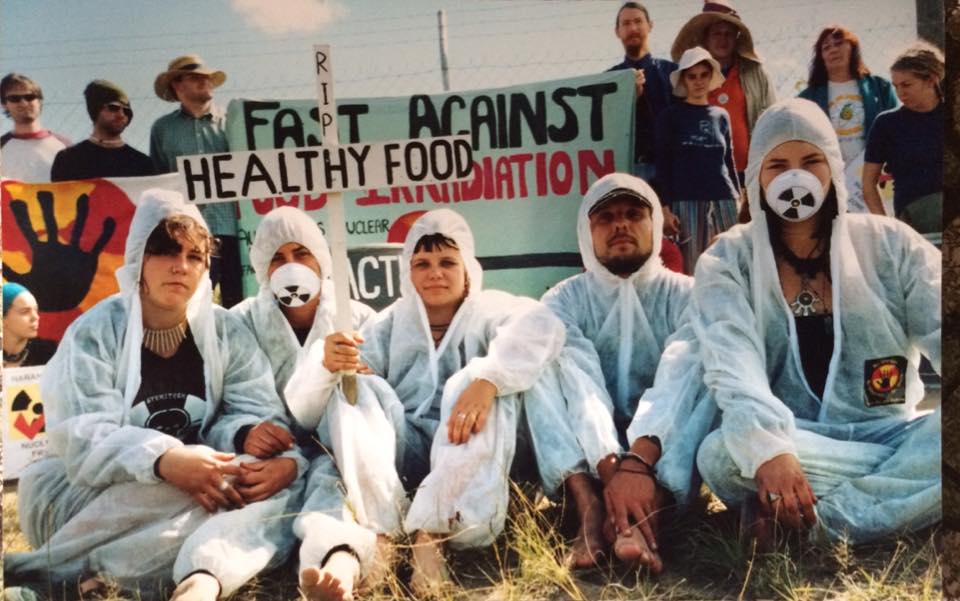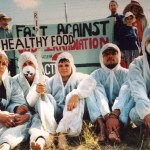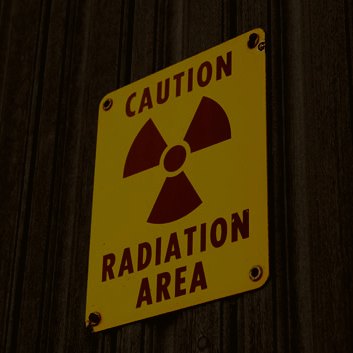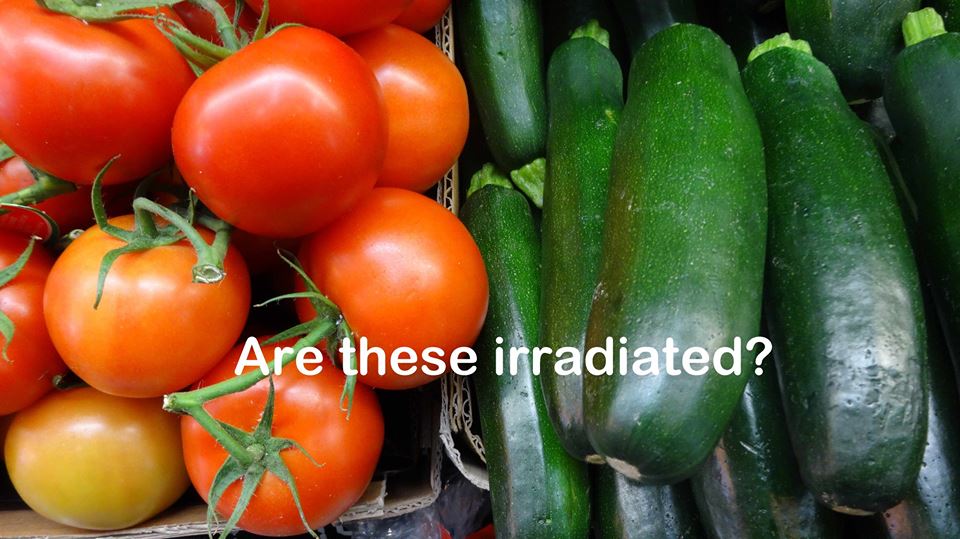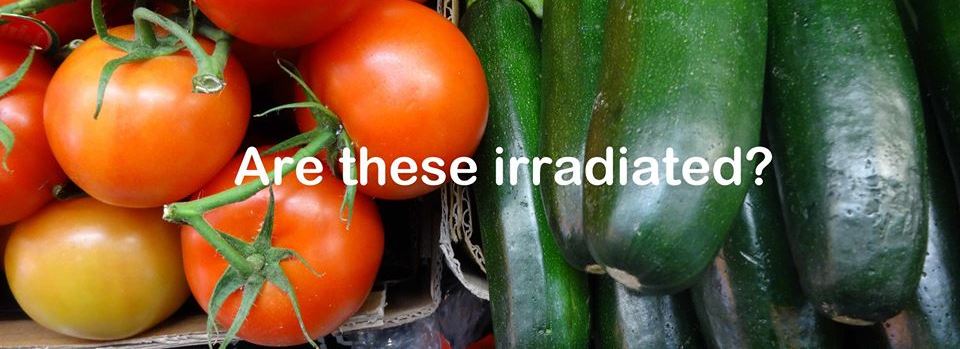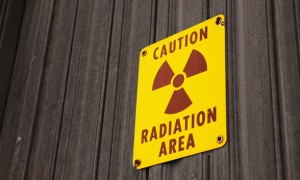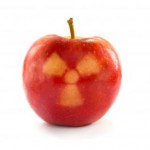

Click each point for a full explanation:
1. Despite their appearance, irradiated fruits and vegetables are processed, not fresh.
2. As irradiation is invisible, without labelling, consumers will have no way to discern whether or not a product has been irradiated. Consumers will be misled into believing irradiated food is fresh or unprocessed.
3. Consumers have strong opinions on irradiated produce and expect it to be labelled.
4. Irradiation is still a new technology with a limited history of safe use in the human food supply.
5. Removal of labelling will disadvantage non-irradiating producers and people who choose to eat irradiation-free.
6. FSANZ and food producers are aware of consumer resistance to irradiated food.
7. Removing labelling to boost sales of irradiated food would be deceitful.
8. Australian & New Zealand labelling requirements already fall short of global standards.
9. Labelling requirements should be strengthened to meet global standards & address community concern. At a minimum, labelling should include prescribed words: “irradiated” or “treated with irradiation”.
10. FSANZ should not be considering regulatory changes to intentionally decrease public awareness about an issue.
1. Despite their appearance, irradiated fruits and vegetables are processed, not fresh.
Irradiated food is processed, not “fresh”: The irradiation of fruits and vegetables typically involves their exposure to the energy equivalent of between 1.5 and 10 million x-rays. When used as a fruit fly larvae treatment, food irradiation also extends shelf life, sanitises, and alters the nutritional value of the treated foods. The substantial and significant changes made to fruits and vegetables as a result of processing with irradiation cannot be discerned with our ordinary senses. Furthermore, irradiation is used in conjunction, not as a substitute for chemicals used in food production, cold storage, cooking and other processing of food.
2. As irradiation is invisible, without labelling, consumers will have no way to discern whether or not a product has been irradiated. Consumers will be misled into believing irradiated food is fresh or unprocessed.
Labelling is the only way to know: As irradiation is invisible, labelling is the only way to ensure that consumer rights are protected, producers of non-irradiated products are not disadvantaged by having their products indistinguishable from irradiated products (or are not forced to label “non-irradiated” or “fresh” to ensure the distinction) and that true market forces are allowed to prevail through consumers being empowered to make fully-informed decisions about what they purchase.
Marketing irradiated fruits and vegetables as fresh would grossly mislead the public and be a failure of duty of care to Australian and New Zealand consumers.
3. Consumers have strong opinions on irradiated produce and expect it to be labelled.
‘In October 2001, FSANZ commissioned qualitative research to examine Australian and New Zealand consumer understanding and use of various label elements (NFO Donovan Research 2001)… The report also noted that the general consensus was that even though the word was alarming and off-putting, that it should be used on packaging rather than a symbol, again because people had a right to know what has been done to their food…”
“Tomatoes NZ (the industry body that represents the fresh tomato sector) commissioned a telephone poll of 1000 New Zealand adults in April 2015 (Curia Market Research 2015). Poll participants were asked if they would like:
- the fruit and vegetables they buy that have been treated with irradiation to be clearly labelled as irradiated. (Eighty-five per cent of participants responded that they would).
- to know if a dish they ordered in a restaurant, café or takeaways includes irradiated food. (Seventy-eight per cent of participants responded that they would). “ (p 14-15)
The public wants irradiated food to be labelled.
Precedence and presumption of labelling: All irradiation approvals to date have been premised on the notion that all irradiated food will be labelled. It would be disingenuous to remove labelling so clearly identified as part of the approval process.
Labelling is correctly listed by Food Standards Australia New Zealand as the only method by which consumers will know if food has been irradiated:
“How can I tell if food has been irradiated?
A food that has been irradiated, or food that contains irradiated ingredients or components, must be labelled with a statement that the food, ingredients or components have been treated with ionising radiation.
If the food is not normally required to be labelled, then the mandatory labelling statement must be displayed close to the food. This would apply to foods such as:
- whole fruit and vegetables sold loose by supermarkets
- a take away pizza with an irradiated herb as an ingredient.
The radura symbol (below) may be used in addition to the mandatory labelling.”
http://www.foodstandards.gov.au/consumer/foodtech/irradiation/Pages/default.aspx
Labelling is the status quo and expected. To remove labelling is to deny the public any access to informed choice and is unconscionable.
4. Irradiation is still a new technology with a limited history of safe use in the human food supply.
Australian and New Zealand have little experience with irradiated foods: Irradiated foods have not been in the Australian food chain for 30 years. In fact the first approval, for herbs and spices, was in 2001 and the list has only recently been extended to include commonly eaten foods such as tomatoes and grapes.
Outside of a few trials, very little irradiated food has been marketed in Australia. New Zealand has received some irradiated produce from Australia, though this is still in niche markets and has not been broadly experienced. The issue of irradiation and labelling, however, have been newsworthy in New Zealand as irradiated Australian produce has the potential to be competition for locally grown non-irradiated items.
Overall, Australians and New Zealanders are unaware of the process of irradiation, and when made aware express concern. It is also clear that Australians and New Zealanders expect products produced using “new” technologies to be labelled. Irradiation is new to most of the public.
It must be noted, however, that in the 1980s, Australian opposition to food irradiation was so strong and publicly acknowledged that a 10- year moratorium was placed on the process in 1989. In 1999, with little public awareness, the moratorium was lifted with plans to construct Australia’s first specifically food- related irradiation facility soon revealed. This facility, at Narangba/Deception Bay – 25 minutes north of Brisbane, is now operating, irradiating food and other commercial items.
Safety cannot be presumed: While our main objective here is to ensure that the public have access to information and choice via accurate information, we must point out that the notion of “safety” is a marketing tool, rather than as a fact.
“Safety” is unsubstantiated. Indeed, FSANZ’s own literature points to the lack of quantified research in to consumption patterns. In a 2014, report FSANZ stated:
“The USA is the second greatest user of food irradiation by volume after China. No consumption data are available, but the amounts sold into the retail trade are known approximately. As the foods have been retailed for several years in a few thousand retail outlets (Eustace & Bruhn 2006), it may be presumed that retailers are actually selling most of the product.” (SD1 page3)
It is farcical to state that irradiation is safe – or has been proven safe – when no data of consumption patterns is available. Safety cannot be “presumed.” With “no consumption data available” a scientific statement as to the safe consumption -let alone the safe consumption for over 30 years – is unprovable – and unacceptable. It is a marketing tool, not a scientific fact – and should not used as a premise for assessment of irradiation applications or as a rationale for removing labelling.
Cat food irradiation banned in Australia after cats developed neurological disorder:
The Animal Biosecurity Branch of the Commonwealth Department of Agriculture confirms that: “In 2008-9, 87 cats in Australia were reported to have developed severe neurological disease (chronic leucoencephalomyelopathy) associated with eating an imported, irradiated dry pet food. … The department … concluded that there was a reasonable body of evidence that gamma irradiation, applied as an adjunct quarantine treatment of pet food, was a contributing factor to the disease syndrome. A cause of great distress to the cat owners was the fact that laboratory research proving the potential for this impact existed but had been disregarded at the time by the parties involved. In its latest irradiation literature review, the European Food Safety Authority (ESFA) has not ruled out the potential significance to humans.
The irradiation of cat food is now prohibited in Australia and dog food requires irradiation labelling. To have lessor or no guidelines for labelling of foods for human consumption is incomprehensible and certainly deceptive to consumers who are aware of the cat and dog food situation.
Recent science around allerginicity:
A recent study shows that smaller irradiation dosages (~1 Gy) can render protein more allergenic than either non-irradiated protein, or protein irradiated at a higher dosage. This is an ignored but potential emerging food safety risk associated with irradiation. Vaz, A.F., et al., Low-dose gamma irradiation of food protein increases its allergenicity in a chronic oral challenge. Food Chem Toxicol., 2012. 51C: p. 46-52-doi: 10.1016/j.fct.2012.09.011.
With limited history in our diet, and no long-term studies conducted, the potential impact of consuming irradiated food cannot be accurately assessed. Ultimately, however, “safety” of the process does not extinguish the public’s right to know about it or necessarily negate public concern. The public expects to be informed when a food has undergone processing and FSANZ has a responsibility to administer that. The current rules on irradiated food labelling should, therefore, be maintained and strengthened.
5. Removal of labelling will disadvantage non-irradiating producers and people who choose to eat irradiation-free.
Producers of non-irradiated foods should not have to bear the potential costs of differentiating themselves from irradiated foods, or the potential loss of market due to consumer inability to distinguish irradiated food from non. Irradiation labelling should be improved to include the labelling of individual fruit and vegetables.
New Zealand has a substantial tomato industry – Australia primarily filling an off-season gap. New Zealand tomato growers are keen to ensure that New Zealand consumers can differentiate between irradiated Australian and non-irradiated local tomatoes.
The Tomatoes NZ chairman Alasdair MacLeod stated “We are demanding compulsory labelling on all irradiated produce, loose or otherwise, be clear and enforced, so that Kiwi consumers can make an informed decision between Australian irradiated tomatoes and New Zealand tomatoes.” http://www.stuff.co.nz/business/farming/cropping/8618860/Fears-over-treated-Aussie-tomatoes Fears over treated Aussie tomatoes NICOLE PRYOR 01/05/2013
Furthermore, labelling is correctly listed by Food Standards Australia New Zealand as the only method by which consumers will know if food has been irradiated:
“How can I tell if food has been irradiated?
A food that has been irradiated, or food that contains irradiated ingredients or components, must be labelled with a statement that the food, ingredients or components have been treated with ionising radiation.
If the food is not normally required to be labelled, then the mandatory labelling statement must be displayed close to the food. This would apply to foods such as:
- whole fruit and vegetables sold loose by supermarkets
- a take away pizza with an irradiated herb as an ingredient.
The radura symbol (below) may be used in addition to the mandatory labelling.”
http://www.foodstandards.gov.au/consumer/foodtech/irradiation/Pages/default.aspx
So far, all irradiation approvals in Australia and New Zealand have been made with the premise and promise that irradiated food will be labelled. Labelling is the status quo and expected. To remove labelling is to deny the public any access to informed choice and is unconscionable.
6. FSANZ and food producers are aware of consumer resistance to irradiated food.
At a 2012 Horticulture Australia Limited (HAL) Forum in Sydney, Paul Harker, head of produce, Woolworths said the industry needed a united voice on the subject before it proceeds…
“It’s going to be an extremely emotional product and we are not going to stand alone trying to convince Australian consumers that there is nothing wrong with irradiation,” Mr. Harker said.
“We’ve communicated that back to industry and we said unless there is a concerted campaign that is led not only by the people peddling irradiation as an alternative, but unless the government and everyone else is involved in actually talking to the customer about it, the last thing I am going to do is plonk it on my shelf because I can tell you that fresh produce sales will die. People won’t shop there.” (our emphasis) http://www.theland.com.au/news/agriculture/horticulture/general-news/irradiation-pros-and-cons/2665981.aspx?storypage=0
In its review document, FSANZ and the Ministerial Council clearly link labelling to the low “uptake” of irradiation foods. (p 5). They also know that people want irradiation food to be labelled – see #3 above.
We ask: Should labelling be removed so that people will buy irradiated food?
7. Removing labelling to boost sales of irradiated food would be deceitful.
In its review document, FSANZ and the Ministerial Council clearly link labelling to the low “uptake” of irradiation foods. (p 5). They also know that people want irradiation food to be labelled – see #3 above.
Removing labelling would be misleading: Labelling is vital and that removal of labels and signage from irradiated fruits and vegetables would create circumstances in which Australian and New Zealand consumers would be led to the false, misleading and deceptive conclusion that irradiated fruits and vegetables are fresh produce.
We ask: Should labelling be removed so that people will buy irradiated food?
8. Australian & New Zealand labelling requirements already fall short of global standards.
Global standards – such as the CODEX guidelines – require irradiated food to be labelled.
In fact, removing labelling would make Australia the odd-ball amongst its trading partners – and likely increase costs for food producers who would need to ensure that their export products are labelled appropriately for overseas markets.
In its consultation paper, FSANZ states:
“FSANZ has reviewed the requirements for food irradiation label information in a number of countries. Most of the countries reviewed appear to have based their requirements on the Codex Standard, although some variations occur.
For irradiated whole foods that are packaged, it is common for a mandatory statement to indicate that the food has been irradiated…
For packaged foods that contain an irradiated ingredient(s), most countries require that the ingredient(s) be identified on the label, usually in the list of ingredients…
Most countries require specific signage for unpackaged foods that have been irradiated (e.g. whole produce) and are sold in bulk….”
Furthermore, “FSANZ does not know whether other countries have previously considered, or are considering, changing or removing their food irradiation information requirements.” (All Public Consultation Paper p10)
We ask: If labelling is the norm and no-one else is considering getting rid of it, why is there a push to do so in Australia and New Zealand?
9. Labelling requirements should be strengthened to meet global standards & address community concern. At a minimum, labelling should include prescribed words: “irradiated” or “treated with irradiation”
Australia and New Zealand’s failure to meet global labelling standards:
Labelling of irradiated food is the norm with our English speaking trading partners and clearly called for in global standards as set by the international Codex Alimentarius. Non-conformity with international standards would betray Australian and New Zealand consumers belief that their regulatory system is world class and reflects their needs and concerns. As it is, FSANZ’s lack of a precise, mandatory labelling regime for irradiated foods fails the public and is unprecedented amongst other English-speaking nations, USA, UK and Canada, and our trading partners.
The current labelling regulations do not:
- prescribe mandatory labelling statements;
- ensure individual labelling of irradiated products;
- or require products such as pet food and animal feed to be labelled.
If FSANZ is to live up to its mandate to provide accurate information to ensure public choice, Australia and New Zealand must improve labelling in accordance with global standards requiring at a minimum, the prescribed words:
- irradiated (name of the food),
- treated with radiation,
- or treated by irradiation
Without these improvements, there is still potential for producers to put forward misleading and deceptive claims.
10. FSANZ should not be considering regulatory changes to intentionally decrease public awareness about an issue.
The recently released FSANZ policy guideline “recognises that labelling on foods produced or processed using a new technology can be an issue of consumer interest” though not necessarily a health or safety issue. Australians and New Zealanders have clearly demonstrated concern about irradiation.
Without labels on irradiated foods, the public would be led to conclude that such foods were fresh and not irradiated. The removal of the mandatory labelling and signage requirements from irradiated fruits and vegetables would create a set of false, misleading and deceptive circumstances for consumers in Australia and New Zealand.
Labelling is the only way to ensure that consumer rights are protected, producers of non-irradiated products are not disadvantaged by having their products indistinguishable from irradiated products (or are not forced to label “non-irradiated” or “fresh” to ensure the distinction.
Australian and New Zealand labelling standards are already weaker than our trading counterparts and world standards. Rather than being removed, labelling should be improved to prescribe clear and accurate statements such as: “Irradiated – “ or “Treated with irradiation.”
In a free market economy, the demand for irradiated products should be driven by consumers making informed and intentional decisions to purchase such products. Irradiators who are confident that their products are wholesome, healthy and desirable should be proud to label their products irradiated and let the market play out.
With Australia and New Zealand set to dramatically increase the amount of irradiated foods available on the market and in people’s diets, the push to remove mandatory labelling and signage requirements is unacceptable and must be stopped.
